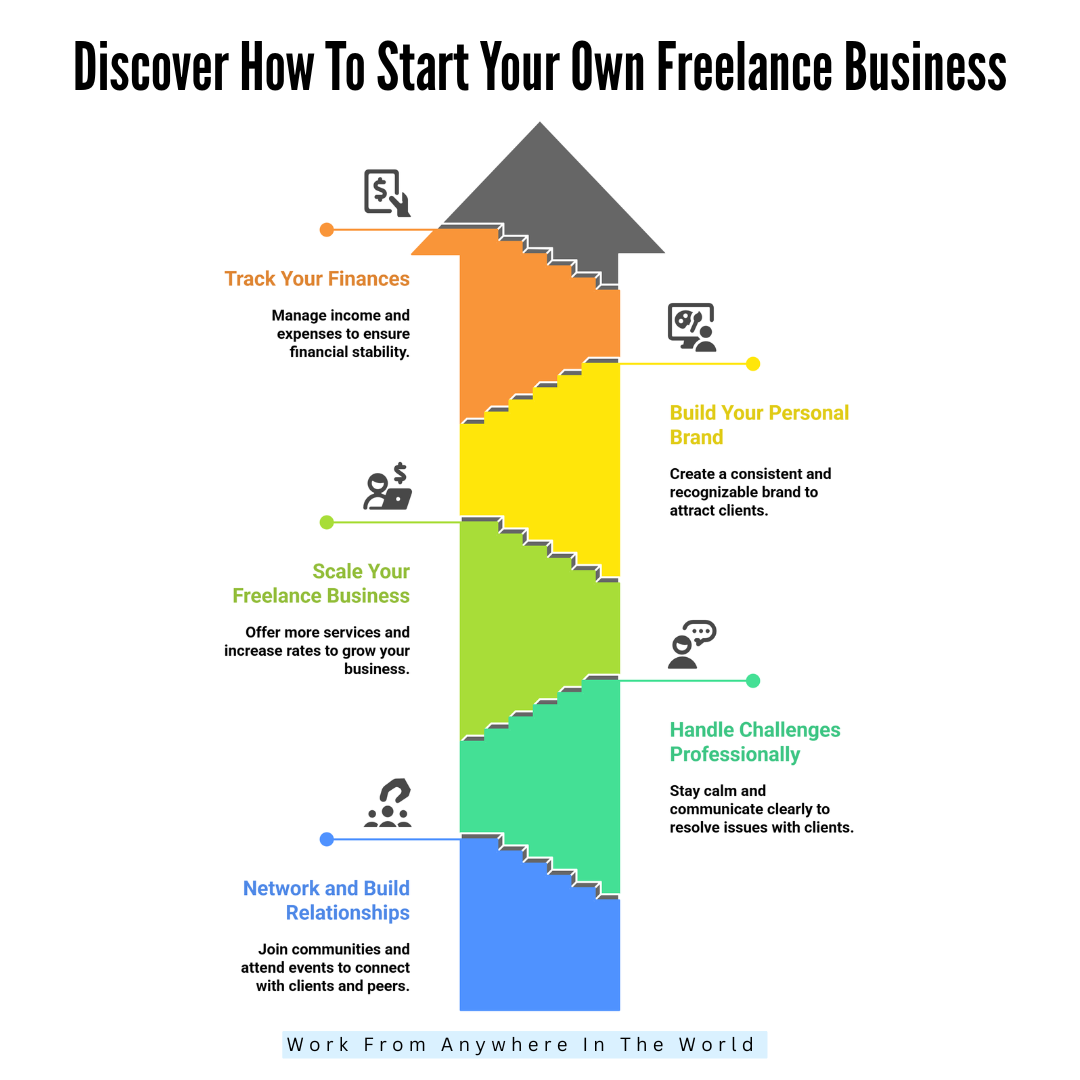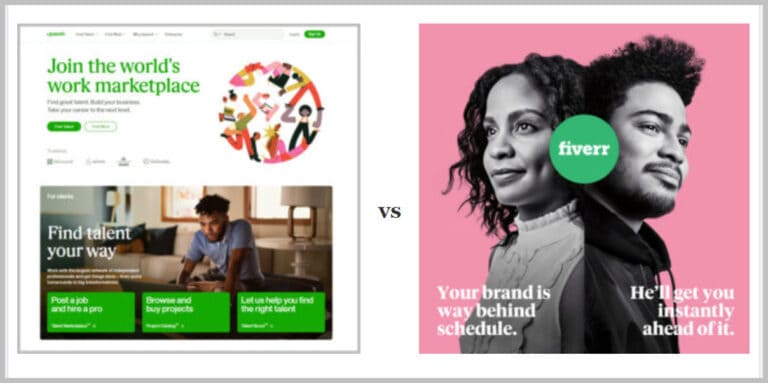Discover How To Start Your Own Freelance Business
Starting your own freelance business opens doors to independence, creativity, and financial freedom. It's your opportunity to use your professional abilities to generate a lucrative income on your own terms.
Learning how to start your own freelance business is the first step toward gaining independence, flexibility, and control over your career.
This guide explains how to choose your niche, attract ideal clients, manage finances, and confidently build a successful freelance business from the ground up with consistency and purpose.
Why Start A Freelance Business
Starting a freelance business opens doors to freedom and flexibility. Unlike a regular 9-to-5 job, you choose your clients, projects, and work hours.
This implies that you can design a timetable that suits your needs, be it free mornings, working remotely, or working on several short-term tasks.
Freelancing also gives you control over your income. You decide how much to charge based on your skills, experience, and the value you deliver.
Another reason to start freelancing is the variety of opportunities. From writing and design to programming and marketing, the digital world offers endless ways to earn.
You may learn, develop, and build your portfolio with every project. You’re not tied to one company or role, which makes work exciting and dynamic.
Freelancing also helps you build professional independence. You develop business skills, communication strategies, and client management expertise that traditional jobs rarely teach.
For anyone seeking freedom, skill growth, and financial control, starting a freelance business is more than an option—it’s a powerful path toward personal and professional empowerment.
How To Start Your Own Freelance Business
Step 1: Research Your Skills
Knowing who you want to work with makes finding clients easier. Are you targeting startups, small businesses, or large companies? Define their industry, size, and type of services they need.
A clear target audience helps you craft better pitches and market yourself effectively. Research potential clients online to understand their challenges and goals. Tailor your services to solve their problems.
Focusing on a specific audience saves time and increases your chances of getting hired. Understanding your clients also builds trust and long-term relationships. Start narrow, then expand as your business grows.
Key Tips
- Identify the type of clients you want.
- Research industries where your skills are needed.
- Focus on clients who value your services.
- Tailor services to solve specific client problems.
Step 2: Define Your Target Audience
Before reaching out to clients, define exactly who you want to serve. Are you aiming for startups, small businesses, or larger companies?
Understand their industry, needs, and challenges. Knowing your audience helps you create tailored services that solve their specific problems.
It also makes pitching easier and more effective. A focused approach saves time and increases your chances of getting hired. Start narrow, gain experience, and expand later.
Understanding your target audience builds trust, encourages repeat work, and helps your freelance business grow steadily while maintaining high-quality client relationships.
Key Tips
- Identify the clients you want to target.
- Research their industry and everyday challenges.
- Tailor your services to the client's needs.
- Start narrow and expand gradually over time.
Step 3: Set Your Freelance Goals
Setting clear goals gives your freelance business direction. Decide how much you want to earn monthly and yearly. Break these into smaller milestones for three, six, and twelve months.
Goals help track progress and keep you motivated. Consider both income and skill development as targets. Beginners can start with achievable objectives, gradually increasing complexity.
Clear goals guide your daily tasks and client choices. They also help measure success and identify areas for improvement.
Regularly review and adjust goals to stay on track. Well-defined goals turn freelancing from random work into a structured, purposeful career.
Key Tips
- Decide on your monthly and yearly income targets.
- Break long-term goals into smaller milestones.
- Include skill growth as part of your goals.
- Review and adjust goals regularly for progress.
Step 4: Choose Your Freelance Services
Understanding how to start your own freelance business helps you choose the right services to offer and attract clients effectively. Focus on one or two services at first to build expertise and credibility.
Popular options include writing, graphic design, web development, and social media management. Offering too many services at the start can dilute your efforts.
Specializing makes it easier to attract clients and charge higher rates. As you gain experience, you can expand your offerings.
Research what clients need most and align your services accordingly. A clear service list helps clients understand how you can solve their problems effectively.
Key Tips
- Focus on one or two services initially.
- Match services with current market demand.
- Specialize to stand out from competitors.
- Expand offerings gradually as experience grows.

Step 5: Build Your Portfolio
Having a solid portfolio is crucial for luring clients. Even if you have no paid experience, create sample projects that showcase your skills.
Writers can draft blog posts or articles, designers can make mock graphics, and developers can build sample websites or apps. Highlight your best work and organize it clearly.
A professional portfolio demonstrates your expertise and builds trust with potential clients. Update it regularly as you complete real projects.
Including diverse examples helps clients see the range of your abilities. Your portfolio is often the first impression, so make it polished, relevant, and easy to navigate.
Key Tips
- Create sample projects if no client work exists.
- Highlight your best and most relevant work.
- Update portfolio regularly with new projects.
- Keep it organized and easy to navigate.
Step 6: Decide Your Freelance Rates
Setting the correct rates is crucial for a sustainable freelance business. To learn about the market, find out how much other independent contractors with comparable expertise charge.
Beginners can start slightly lower, but avoid undervaluing themselves. Decide between hourly rates or fixed project fees depending on the service.
Track your time and effort to ensure you are earning fairly. As your experience and portfolio grow, gradually increase your rates. Transparent pricing builds trust with clients.
Remember, your rates should reflect your skill, quality, and the value you provide. Proper pricing ensures your freelance business remains profitable and professional.
Key Tips
- Research market rates for your skills.
- Choose hourly or fixed project pricing.
- Start slightly lower but avoid underpricing.
- Increase rates as experience and demand grow.
Step 7: Set Up Your Workspace
Creating a dedicated workspace is a crucial step when learning how to start your own freelance business for better focus and productivity.
Make sure you have a comfortable chair and enough illumination to support extended workdays. Keep essential tools like your laptop, software, and notebooks organized.
Even if you work from home, a clean and functional setup helps separate work from personal life. Personal touches like plants or inspirational items can make the space inviting.
A well-arranged workspace encourages efficiency, creativity, and professionalism. Over time, this environment helps you maintain a consistent routine and deliver high-quality work to clients while staying motivated.
Key Tips
- Choose a quiet area with minimal distractions.
- Ensure proper lighting and a comfortable chair.
- Keep all essential tools organized and accessible.
- Personalize your space to stay motivated and focused.
Step 8: Create Your Online Presence
To draw in customers, you must have an internet presence. Create a polished portfolio or website that highlights your achievements, abilities, and services.
Provide your contact information clearly so that prospective customers may get in touch with you. Engage with and share your work with your target audience by using social media platforms like Instagram, Twitter, and LinkedIn.
Freelance marketplaces like Upwork, Fiverr, or Behance can help beginners get initial clients. Consistency and professionalism online build credibility and trust.
Regularly update your profiles with new projects, testimonials, and achievements to stay relevant and visible in a competitive market.
Key Tips
- Build a professional website or portfolio online.
- Include clear contact information for inquiries.
- Use social media to showcase work consistently.
- Update profiles regularly with new projects and testimonials.

Step 9: Learn How To Pitch Clients
Pitching effectively is key to winning freelance work. Write personalized messages for each potential client. Emphasize how your abilities can help them with their unique issues. Avoid generic or copy-paste pitches, as they rarely succeed.
Keep your message concise, professional, and focused on client benefits. Follow up politely if you don’t receive a response, as persistence often pays off. Research each client before pitching to understand their needs and industry.
A well-crafted pitch builds trust and increases your chances of landing projects. Practice refining your pitch over time to make it more compelling.
Key Tips
- Personalize every pitch for each client.
- Focus on solving client-specific problems.
- Keep messages concise and professional.
- Follow up politely if no response occurs.
Step 10: Manage Your Freelance Projects
Efficient project management ensures you deliver quality work on time. Use tools like Trello, Asana, or Notion to organize tasks and deadlines. Break larger projects into smaller steps to stay on track.
Communicate regularly with clients to clarify expectations and provide updates. Set realistic timelines and avoid overcommitting to maintain quality.
Tracking progress helps identify bottlenecks and improve workflow. Staying organized reduces stress and builds client trust.
Developing strong project management habits early ensures smoother operations as your freelance business grows, making it easier to handle multiple clients while maintaining professionalism and high-quality deliverables.
Key Tips
- Use project management tools to stay organized.
- Break large projects into manageable tasks.
- Communicate regularly with clients about progress.
- Set realistic deadlines and avoid overcommitting.
Wealthy Affiliate – Mini Review (2025)
If you’ve ever thought about turning your blog, passion, or niche into an online business,
Wealthy Affiliate (WA) is one of the most beginner-friendly platforms I’ve used.
It combines step-by-step training, website hosting, SEO research tools,
and an active community all in one place.
What I like most: you can start free (no credit card needed),
explore lessons, test the tools, and connect with other entrepreneurs
before upgrading. WA isn’t a “get rich quick” scheme — it’s a platform where success comes
from consistent effort and applying what you learn.
Step 11: Handle Invoices And Payments
Understanding how to start your own freelance business includes learning to manage invoices and payments professionally for consistent cash flow and client trust.
Use professional invoices that clearly list services, rates, and due dates. Payment platforms like PayPal, Wise, or direct bank transfers make transactions secure and straightforward. Keep records of all invoices for accounting and tax purposes.
For larger projects, consider requesting partial upfront payments to reduce risk. Clear communication about payments avoids misunderstandings and ensures a professional relationship.
Proper invoicing and payment management help maintain cash flow and build client trust, which is essential for long-term success.
Key Tips
- Agree on payment terms before starting work.
- Use professional invoices with precise details.
- Keep records for accounting and taxes.
- Consider partial upfront payments for large projects.
Step 12: Improve Your Skills Continuously
Freelancing is competitive, so continuous learning is essential. Keep abreast of the most recent instruments, fashions, and methods in your field. Take online courses, attend webinars, read blogs, and practice regularly.
Expanding your skill set makes you more valuable to clients and allows you to offer advanced services. Experiment with new approaches and gather feedback to improve.
Learning also boosts confidence and helps you adapt to changing market demands. Clients prefer freelancers who evolve with industry trends.
By investing in skill development, you increase your earning potential, reputation, and long-term success in the freelance marketplace.
Key Tips
- Take online courses to expand knowledge regularly.
- Practice new skills to improve proficiency.
- Stay updated with industry trends and tools.
- Seek feedback to refine and enhance services.

Step 13: Network And Build Relationships
Freelancing isn’t just about skills; it’s about connections. Join online communities, attend webinars, and engage on LinkedIn or social media.
Building relationships with clients, peers, and mentors opens opportunities for referrals and collaborations. Happy clients can recommend you, creating a steady stream of projects.
Participate in offline and online networking events to increase your reach. Participate in discussions, share insights, and offer help where possible. Strong professional relationships increase credibility and trust.
Networking consistently helps you learn industry trends, find new clients, and grow your freelance business sustainably while maintaining a supportive professional community.
Key Tips
- Join online communities in your niche.
- Engage with peers and mentors regularly.
- Ask satisfied clients for referrals and testimonials.
- Attend webinars and networking events consistently.
Step 14: Handle Challenges Professionally
Freelancing comes with ups and downs. Clients may delay payments, change project scope, or give difficult feedback. Stay calm and communicate clearly to resolve issues.
Knowing how to start your own freelance business also means learning to handle challenges professionally to maintain client trust and long-term success.
Learn from mistakes and adapt processes to prevent future problems. Setting boundaries and managing expectations up front reduces misunderstandings.
Challenges are opportunities to improve your skills, client relationships, and business processes. Resilience, patience, and a positive mindset help you overcome setbacks.
Handling difficulties professionally enhances your reputation, builds trust with clients, and ensures long-term success in the freelance industry.
Key Tips
- Stay calm and communicate clearly with clients.
- Learn from mistakes and adapt processes.
- Set boundaries and manage expectations upfront.
- Maintain professionalism even during difficult situations.
Step 15: Scale Your Freelance Business
Once you’re comfortable with projects and clients, focus on scaling your freelance business. Offer additional services, increase rates, or hire subcontractors to handle more work.
Create digital products like eBooks, courses, or templates to generate passive income. Streamline workflows with tools and automation to save time.
Expanding your network helps attract larger clients and higher-paying projects. Scaling doesn’t happen overnight; take gradual, consistent steps while maintaining quality.
A well-planned growth strategy allows you to transform freelancing from a side income to a full-time, sustainable business. Scaling increases revenue, reach, and long-term opportunities.
Key Tips
- Offer additional services to attract more clients.
- Increase rates as your experience grows.
- Create digital products for passive income streams.
- Streamline workflows with tools and automation.
Step 16: Build Your Personal Brand
Learning how to start your own freelance business includes building a strong personal brand to attract clients and stand out professionally.
Your brand reflects your style, values, and expertise, creating a memorable impression for clients. Consistency across your website, social media, and portfolios strengthens credibility and professionalism.
Share your knowledge through blogs, posts, or tutorials to showcase expertise. Highlight your successes and client testimonials to build trust.
A recognizable brand makes clients feel confident hiring you and encourages repeat business. Investing in personal branding not only attracts new clients but also positions you as an expert in your niche, boosting long-term freelance growth.
Key Tips
- Define your unique style and voice.
- Maintain consistency across online platforms.
- Share expertise through blogs or social media.
- Highlight successes and client testimonials.
Step 17: Track Your Finances
Managing finances is essential for a successful freelance business. Keep track of all income, expenses, and invoices to understand your cash flow—separate personal and business accounts to simplify accounting.
Set aside money for taxes and unexpected costs. Use spreadsheets or accounting apps to monitor earnings and expenses accurately. Regular financial tracking helps you make informed decisions, adjust rates if needed, and plan for growth.
It also prevents last-minute stress during tax season and ensures your business remains profitable. Staying organized with finances builds confidence and supports long-term sustainability in freelancing.
Key Tips
- Track all income and expenses consistently.
- Separate personal and business finances clearly.
- Set aside funds for taxes regularly.
- Use apps or spreadsheets for accurate tracking.

Conclusion
Knowing how to start your own freelance business is the key to achieving freedom, financial independence, and long-term professional fulfillment.
Continuous learning, networking, and personal branding help you grow and attract clients. With persistence, organization, and clear goals, freelancing can become a rewarding, long-term venture that provides both financial independence and professional fulfillment. Start small, stay consistent, and scale gradually.
I trust you enjoyed this article on Discover How To Start Your Own Freelance Business. Please stay tuned for more insightful blogs on affiliate marketing, online business, and working from anywhere in the world.
Take care!
— JeannetteZ
💬 Your Opinion Is Important To Me
Do you have thoughts, ideas, or questions? I’d love to hear from you. Please leave your comments below or email me directly at Jeannette@WorkFromAnywhereInTheWorld.com.
📚 More Work From Anywhere Reads
🚀 Ready to Build a Business You Can Run from Home
Or from Anywhere in the World?
Imagine creating income on your terms — from home, a cozy café, or wherever life takes you.
With the right tools, training, and community support, it’s entirely possible.
Start your own online business for free — no credit card needed.
Disclosure
This post may contain affiliate links. As an Amazon Associate, I earn from qualifying purchases. I also earn through other affiliate programs. Please read my full affiliate disclosure.







